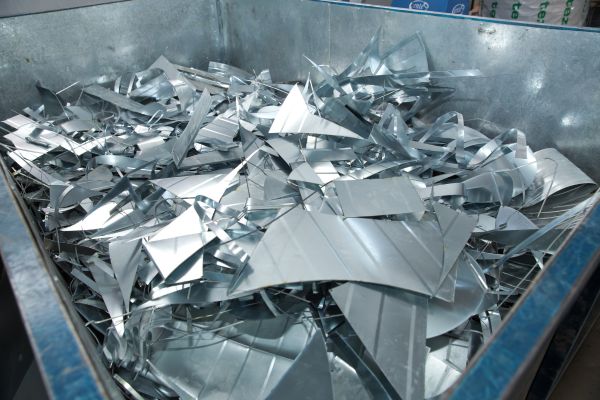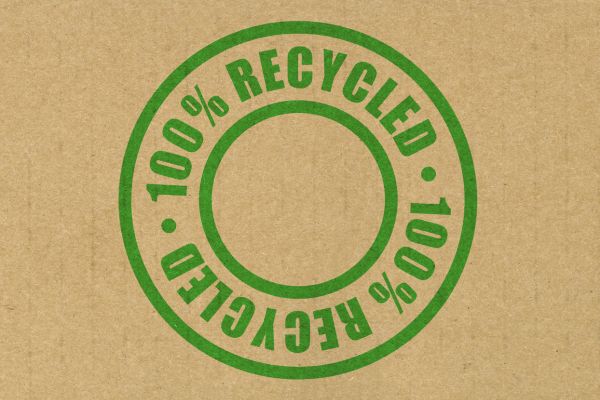Post-consumer recycled content refers to materials that have been used and discarded by consumers, such as plastic bottles, paper products, or aluminum cans, and then collected, processed, and transformed into new products. There are two key benefits to using post-consumer recycled content. Firstly, it helps reduce the amount of waste sent to landfills, conserving natural resources and reducing environmental impact. Secondly, it creates a demand for recycled materials, promoting recycling practices and supporting the development of a circular economy.
What is post-consumer recycled content?
Post-consumer recycled content (known as PCR) refers to recycled material that comes from products or packaging that have already served their intended purpose, such as a bottle, bag, or newspaper. It’s created by consumers after a product has reached the end of its use. These materials have then been recycled by the consumer, either through curbside recycling or specialist recycling services, processed at a material recovery facility, and transformed into useful materials that can then be used to manufacture new products.
In contrast, pre-consumer recycled content (or post-industrial recycled content (PIR)) is generated by companies during the manufacturing process. Often these materials are immediately placed back into the manufacturing process, or they may be sold or donated to other manufacturers for use in other products. I’ll explain pre-consumer recycled content further down.
What are some examples of post-consumer recycled content?
Typical examples of PCR that you might encounter are:
- Aluminum cans: After a can has been used and disposed of by a consumer, it’s collected through recycling programs and separated from other aluminum materials. The cans are then sent to a manufacturer, where they are melted down and used to create new aluminum products.
- Plastic Bottles: When a consumer recycles plastic water bottles made from PET, they are collected, sorted, cleaned, and processed into plastic resin. This plastic resin is then purchased by many different manufacturers and turned into new products. For example, textile manufacturers will purchase the resin and use it to make fabric which can then be used to make clothing and accessories such as the activewear leggings made by Wolven.
- Plastic milk jugs: Following the collection of plastic milk jugs made from high-density polyethylene (HDPE), they are separated and processed through curbside recycling. The resulting material can then be used to create products like kid’s toys. One great example is Green Toys which uses 100% post-consumer recycled HDPE in its children’s toys range.
What is the difference between Post-Consumer Recycled Content and Pre-Consumer Content?
Understanding the difference between these two terms is important for making informed choices about environmentally sustainable products.
Post-Consumer Recycled Content (PCR):
- PCR refers to materials that are recycled after they have been used by consumers or reached the end of their intended life cycle. This includes items that are collected through household recycling programs or returned to recycling centers after consumer use. Typical examples of PCR materials include aluminum cans, plastic bottles, paper products, and glass containers.
Pre-Consumer Content (PCC):
- PCC, also known as post-industrial or pre-consumer waste, refers to materials that are recycled before they reach consumers or are used in the manufacturing process. These materials include scraps, excess materials, and faulty or defective products generated during the production or manufacturing of goods. They are diverted from the waste stream by either:
- reinserting them directly into the manufacturing process
- creating another product from them
- or selling or giving them to other manufacturers who can use the material.

Key Differences between PCR and PCC:
- Timing: PCR materials are recycled after they have been used by consumers, while PCC materials are recycled before reaching consumers.
- Source: PCR materials come from households and consumers, whereas PCC materials come from industries and manufacturing facilities.
- Purpose: PCR materials address the disposal of materials that have already served their intended purpose, while PCC materials focus on reducing waste generated during the manufacturing process.
- Environmental Impact: Both PCR and PCC contribute to sustainability by reducing the use of virgin materials and diverting waste from landfills. However, PCR has a more direct environmental impact as it tackles the disposal of materials that have already been used by consumers.
Which is better? Post-Consumer or Pre-Consumer?
Both PCR and PCC reduce the demand for virgin materials, conserve natural resources, and divert waste from landfills. However, post-consumer content is considered a more sustainable option because it has a more immediate environmental impact as it deals with waste disposal issues of materials that consumers have already used.
Benefits of using products with post-consumer recycled content
1. Reduce landfill waste
One of the key benefits of using products with post-consumer recycled content is reducing landfill waste. Landfill disposal is currently the most common waste disposal method, with approximately 50% of waste ending up in landfills worldwide. This not only takes up valuable land space but also contributes to environmental pollution and degradation. By using PCR-based products, the demand for landfill space is reduced, allowing for more effective waste management and a decrease in landfill pollution.
2. Create demand for recycled materials
Creating demand for products with post-consumer recycled content supports the recycling industry. It provides a market for recycled materials, incentivizing the collection and processing of recyclables. This, in turn, helps sustain and grow the recycling infrastructure and helps to drive innovation, leading to more efficient and effective recycling processes. Overall this will build a more resilient recycling industry.
The demand for products with post-consumer recycled content also encourages companies to invest in research and development to improve manufacturing technologies and processes to incorporate recycled content.
3. Keep recycling onshore
Another advantage of increasing products containing post-consumer recycled content is encouraging more localized processing and manufacturing. This in turn can mean less recycling material is sent to foreign countries for processing. Currently, about one-third of the 66 million tons of material recycled annually in the United States is exported for processing. However, unfortunately, some of these destination countries do not have the same work and environmental standards. This can lead to more environmental issues and even impact the health of local communities in those countries. PCR-based products can help to increase the demand for recycled material and build local markets.
4. Reduce the amount of virgin materials used
When products are made from post-consumer recycled content, there is a reduced need for extracting and processing raw materials. The exploration, extraction, processing, and transportation of these materials have a significant impact on our environment, including:
- A significant amount of energy, materials, and equipment is used for the exploration of mineral or oil deposits.
- The extraction of resources, whether minerals and fossil fuels or even timber and other renewable materials, is an energy-intensive process with significant environmental impacts.
- Many of the materials we use in products are non-renewable, in particular those from mining. This means that there is a finite quantity of them on the earth, and one day we will run out. So we must preserve them for our future and that of future generations.
Reusing materials, whether pre or post-consumer waste, is imperative to reduce our overall impact on our planet’s environment. Through its use, we can conserve valuable natural resources and protect the environment.
5. Reduce the carbon footprint of production processes
Using PCR content in packaging and other products significantly reduces the carbon footprint of production processes and promotes sustainability efforts.
The benefits of using products with post-consumer recycled content include:
- Reduction in energy consumption: The production of new materials from virgin resources requires a significant amount of energy. The recycling process eliminates the need for extracting, refining, and processing raw materials resulting in much lower energy consumption.
- Lower greenhouse gas emissions: The energy saved in the production of recycled products translates into reduced greenhouse gas emissions. This helps to mitigate climate change and reduce the overall carbon footprint of production processes.
6. Promotes the circular economy:
The use of PCR content promotes the concept of a circular economy, where materials are kept in use for as long as possible and recycled or repurposed at the end of their life cycle. By incorporating recycled materials into new products, the lifecycle of these materials is extended, reducing the need for new production and minimizing waste generation.
Learn what is the circular economy in our beginner’s guide to the circular economy.
7. Economic benefits:
Recycling and incorporating PCR content into products can create economic opportunities and contribute to job creation. Recycling industries require a workforce to collect, sort, process, and manufacture recycled materials. This creates employment opportunities and stimulates economic growth. Additionally, well-run recycling programs can be more cost-effective than waste collection and disposal methods, resulting in potential cost savings for businesses and communities.
7. Encourages sustainable consumer behavior:
When consumers see products with post-consumer recycled content, it raises awareness about the importance of recycling and the potential for their own actions to make a difference. This can lead to a shift in consumer behavior towards more sustainable choices and an increased demand for products with recycled content. For example, if consumers see that a brand uses post-consumer recycled plastic in their packaging, they may be more likely to choose that product over one with non-recycled packaging.
8. What about the quality of Post-consumer products
Post-consumer recycled packaging materials are designed to meet the same quality standards as traditional packaging materials. This means that products made with post-consumer recycled content are able to maintain the same level of quality and functionality as products made with virgin materials.
For example:
- Post-consumer recycled plastics can be transformed into packaging materials that are just as strong and resistant to damage as plastics made from virgin materials.
- Recycled paper fibers are processed and treated to ensure that the resulting paper is strong, smooth, and suitable for various applications. This means that recycled paper towels, for example, can effectively absorb liquids and perform their intended function just as well as paper towels made from virgin fibers.
- Recycled aluminum can be processed and transformed into high-quality components that are just as strong and durable as those made from primary aluminum.
Tips on how to find products with post-consumer recycled content
Buying and using products that contain post-consumer recycled content is crucial for promoting sustainability and reducing the environmental impact of consumer goods. By taking the time to investigate products and understand whether they contain recycled content, you can make informed choices that align with your values and contribute to a more sustainable future.
Not sure where to start? Why not take a look at our recycled product and brand directory? We do the work for you and find all the brands and products that have recycled content.
Researching Products for Post-Consumer Recycled Content:
- Start with the label: Look for products that explicitly state they are made with recycled content. Manufacturers often include this information on the packaging or product label. Keep an eye out for phrases like “made with post-consumer recycled materials” or “contains X% post-consumer recycled content.”
- NOTE: If a product displays the universal recycling symbol (the Mobius Loop or three chasing arrows) this does not mean the product has any recycled content. It also doesn’t mean that the item is recyclable. Learn more about recycling symbols.
- Check for certifications: Look for certifications that verify the post-consumer recycled content of a product. Certifications like the Forest Stewardship Council (FSC) or the Sustainable Forestry Initiative (SFI) ensure that the product’s materials come from responsibly managed sources. Similarly, certifications like the Recycled Claim Standard (RCS) and Global Recycled Standard (GRS) indicate that the product contains a certain percentage of recycled content. These certifications provide reassurance that the product meets specific standards for recycled content. Learn more about eco certifications.
- Research the brand’s sustainability initiatives: Explore the brand’s website or other reliable sources to learn about their sustainability practices and commitments. Look for information on their use of post-consumer recycled content in their products. Many brands now publicly disclose their goals and progress in sourcing materials from recycled content. This transparency indicates a commitment to sustainability and can help you make an informed decision.
- Consult reliable sources: Utilize reputable sources that provide information on sustainable products and their recycled content. Websites, blogs, and publications dedicated to sustainability or eco-friendly living often review and recommend products with post-consumer recycled content. These sources can provide valuable insights, recommendations, and comparisons to help you make informed choices.
- Read product reviews: By reading product reviews, you can gain insights from other users who have already purchased and used the products. These reviews can provide valuable information about the durability, functionality, and overall satisfaction of recycled content products. Furthermore, product reviews can also shed light on any potential issues or drawbacks associated with recycled materials in the product, allowing you to make informed decisions.
- Reach out to the manufacturer: If you cannot find clear information about a product’s recycled content, consider contacting the manufacturer directly. Reach out via email or their customer service channels to inquire about the recycled content of their products. Manufacturers who prioritize sustainability will be more than willing to provide this information and address any concerns or questions you may have.
- Consider the overall sustainability of the product: While post-consumer recycled content is important, it is also essential to consider the overall sustainability of the product. Look for products that are designed with other eco-friendly features, such as minimal packaging, non-toxic materials, or energy-efficient production processes. Taking a holistic approach to sustainability will ensure that you are making the most environmentally conscious choice.
How is post-consumer recycled content used in products?
Here are several ways businesses can effectively incorporate Post-Consumer Recycled Content into product design and manufacturing:
- Sourcing materials:
- Establish partnerships with recycling programs and facilities to source post-consumer recycled materials. This ensures a consistent supply of recycled content for the manufacturing process.
- Conduct thorough research to identify suppliers that offer high-quality post-consumer recycled materials suitable for the specific product requirements.
- Consider the environmental footprint of their suppliers and choose those that prioritize sustainable practices throughout their operations.
- Manufacturing processes:
- Optimize manufacturing processes to incorporate post-consumer recycled content effectively. This may involve adapting machinery or procedures to accommodate recycled materials.
- Train employees on handling and processing post-consumer recycled materials to ensure proper integration into the manufacturing process.
- Implement quality control measures to maintain product integrity and ensure that the use of recycled content does not compromise product performance or safety.
By doing these things, businesses can provide better choices for consumers while contributing to a more sustainable future, reducing waste, and minimizing their environmental footprint.
How is post-consumer recycled content used in packaging?
Post-consumer recycled content can be used either in packaging or in the products themselves. Here are some examples of packaging made with recycled content:
- A soda company may use post-consumer recycled content to create new plastic bottles for their beverages.
- Post-consumer recycled content may be used in the production of paper packaging, such as boxes, bags, and tissue paper.
- A clothing brand may use PCR in its product packaging by opting for boxes made from recycled cardboard or mailers made from recycled plastic.
- Even the labels and stickers on packaging can incorporate PCR. These small but significant components can be made from recycled materials, ensuring that every aspect of the packaging is environmentally friendly.
- A food company might choose to use labels made from post-consumer recycled paper for their product packaging.
- A cosmetics brand could use inserts made from post-consumer recycled cardboard to hold their products securely in the packaging.
Clearly communicating the use of post-consumer recycled content on product packaging help consumers make informed decisions.

In Conclusion
Post-consumer recycled content refers to materials that are recycled by consumers and transformed into new products or packaging. It’s different from pre-consumer recycled content, which is generated by companies during the manufacturing process. PCR plays a vital role in promoting sustainability by minimizing waste in landfill, reducing the need for virgin materials, and supporting the circular economy.
Researching the products you are interested in and determining if they contain post-consumer recycled content or finding alternatives that do helps you make informed choices that contribute to a more sustainable future.














